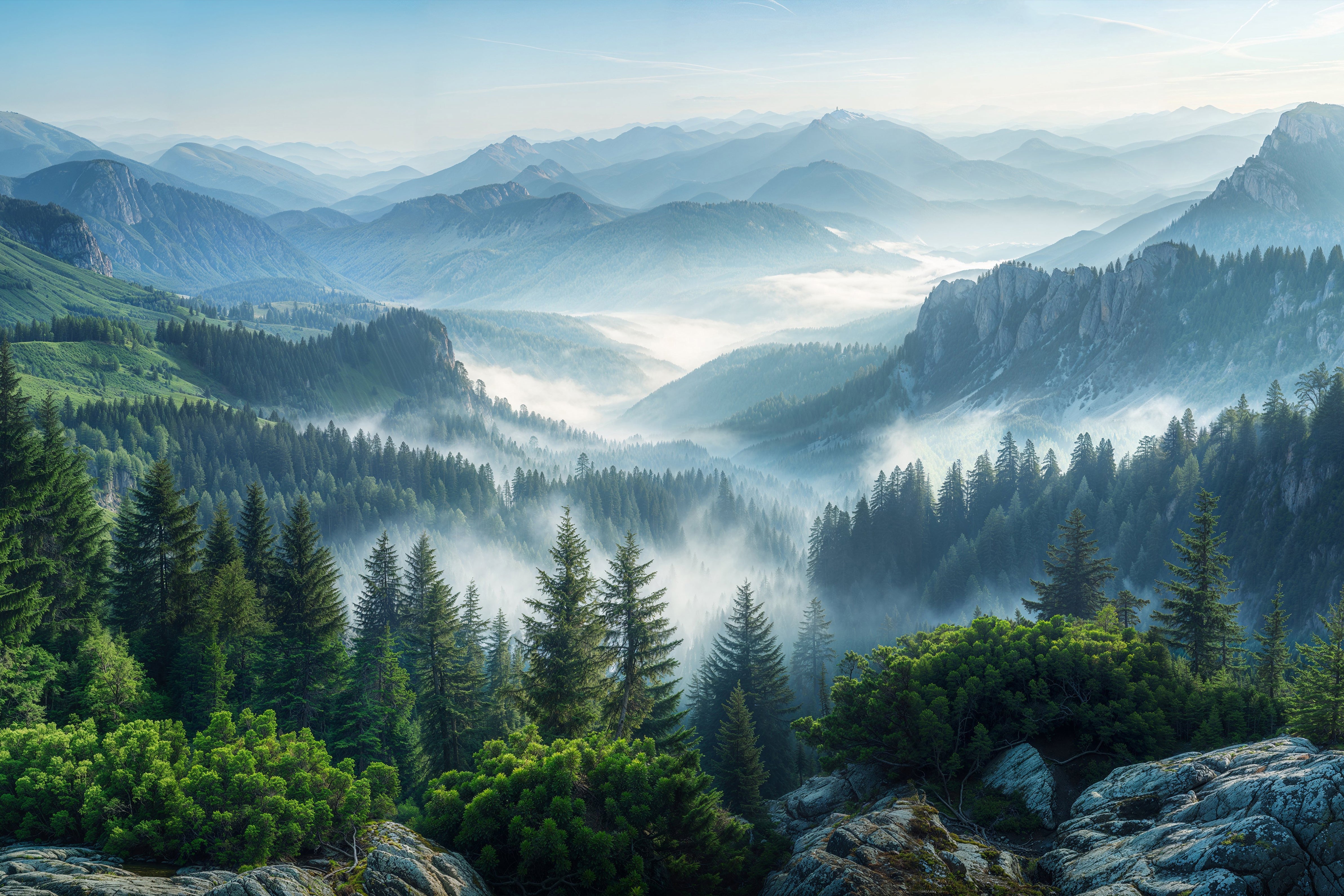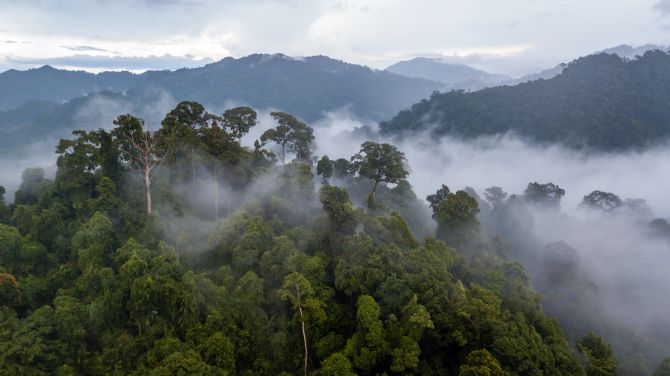FOG
Fog is a low-lying cloud and its moisture is generally locally generated. Fog appears when water vapor condenses into tiny droplets that are suspended in the air. It is highly influenced by nearby bodies of water, wind and topography. According to the generally accepted definition, fog reduces visibility to less than one kilometer. Giants redwoods, the biggest and oldest trees on the planet, receive almost 40% of their moisture from coastal fog through fog drip. Insects depend on wet fog as their principal source of water.
The disappearance of fog would
FOG CATCHERS
In particularly dry regions where rain is rare or non-existent, like along the Peruvian coastal region, in Mexico, Bolivia, Colombia, people have been trying to catch - to harvest - water from fog using mesh strung up on hillsides. Tiny droplets condense on the netting and dribble down into pipes that carry the water into containers where it can be used to irrigate crops or even as drinking water. Each net can capture between 200 and 400 liters of fresh water per day. More technologies are being developed. For instance, two Chilean architects are developing fog harvesting towers to collect water as high as possible in the fog.
CLOUD FORESTS
Cloud forests or water forests are generally tropical or subtropical moist forests characterized by a frequent, persistent or seasonal low-level cloud cover, usually at the canopy level. Cloud forests are amongst the most biodiversity rich ecosystems, with a large number of species directly or indirectly depending on them. Only 1% of the woodland consists of cloud forests. In the 1970’s they comprised over 11% of all tropical forests. A total of 736 cloud forests have been identified in 59 countries by the UN’s World Conservation Monitoring Center. Half of these cloud forests are located in Latin America. Because of their dependency on local climate, these forests are affected by climate change. It would greatly impact species living in those areas like frogs and lizards, for example and cause the extinction of species.
CLOUDS
At any given moment, about two-thirds of our planet is covered by clouds. So it’s not too surprising that clouds play an important role in Earth’s climate. They affect climate in two major ways. First, they are an essential part of the water cycle. Clouds provide an important link between the rain and snow, oceans and lakes, and plants and animals. Secondly, clouds also have an important effect on Earth’s temperature. Clouds can both cool down and warm up the temperatures on Earth. Clouds within a mile or so of Earth’s surface tend to cool more than they warm. These low, thicker clouds mostly reflect the Sun’s heat. This cools Earth’s surface. Clouds high up in the atmosphere have the opposite effect: They tend to warm Earth more than they cool. High, thin clouds trap some of the Sun’s heat. This warms Earth’s surface. Climate scientists predict that as Earth’s climate warms, there will also be fewer clouds to cool it down. So, unfortunately, we can’t count on clouds alone to slow down the warming.
FLYING RIVERS
Flying rivers are moisture-laden air currents - aerial rivers - formed above the Amazonian rainforest and extend over a large part of the South American continent. Flying rivers are created by the water vapor released by the billions of trees in the Amazon forest. On average, a forest tree releases 1,000 liters of water vapor into the atmosphere every day - 8 times more than oceans. Flying rivers are responsible for sustaining rainfall in the Amazon and South American region. A study by Brazilian climate scientist, Antonio Nobre, has determined that without the flying river, 70% of Brazil would turn into a desert.
MONSOON
A monsoon is the reversal of winds accompanied by heavy precipitations.
The monsoon is much more than rain — it’s a collective mood, a shared experience across communities and across time, and deeply ingrained. Artists and poets have tried to capture it for centuries. Novelists use it as a plot device, and it provides rainy, romantic interludes in countless Bollywood movies. And the monsoon is an economic force, particularly for the small farmers who get three-quarters, or more, of their annual rainfall from it. A good monsoon can bring plenty, a bad monsoon, hardship. And in the past, a terrible monsoon could bring famine.
The monsoon is becoming more erratic because of a basic bit of science: Warmer air holds more moisture. The moisture accumulates in the atmosphere and can stay there longer, increasing the length of dry spells. But then, when it does rain, it dumps all that moisture in a very short time. It can be a month’s rainfall or a week’s rainfall in a few hours to a few days.
FIREFLIES
Fireflies belong to the family of beetles that has more than 2,000 species, most of them light emitting. They produce light, through a chemical reaction inside their abdomen, primarily at dusk, to attract males. They live in marshes or in wet and wooded areas where their larvae find abundant food. Moist atmospheric conditions are very important for them to thrive. Fireflies have attracted humans since ancient times. Japanese have a particular reverence for fireflies and have set aside parks specifically for them, called hotaru. There is even a festival of fireflies each year in June. In poetry, they are a metaphor for passionate love.
SKYSCAPE
When looking at the skyand all the aerial phenomena, we observed how artists through the ages had themselves looked at the sky and at the way light is reflected. We particularly loved looking at Japanese master Hiroshi Sugimoto’s “Seascapes”. Shot in different parts of the world, always the same way, always in black and white, his photographs seem to fuse sea and sky and allow us to look at the Earth as a meditative experience
WIND
Wind is the natural movement of air or other gasses. It is caused by differences in atmospheric pressure which are mainly due to temperature differences. When a difference in atmospheric pressure exists, air moves from the higher to the lower pressure area resulting in winds of different speeds. The two major factors of large scale wind patterns are the differences in heat between the Equator and the Poles and the rotation of the planet. In arid climates, winds are the major source of erosion. But a positive role the wind plays is in seed dispersal. Seeds can float on the breeze or flutter to the ground.
SEEDS
Seeds are the embryonic stage of a plant’s life cycle. It is often contained within a fruit to help its spreading. Seeds serve several functions for the plants that produce them. Key among these functions are embryo nourishment, dispersal to a new location, and dormancy when growth stops during unfavorable times. Plants have evolved in many ways to disperse their offspring by dispersing their seeds - by wind, by water, by animals (for instance, seeds with hooks which attach to the fur or wool of animals). The seed we have embroidered on some of the garments is the Starflower - or Lomelosia stellata. Also known under the name Scabiosa stellata, it is native of southwestern Europe. The name Scabiosa is derived from the latin word ‘Scabere’ which means “to scratch”. It is found in abandoned fields, roadsides. Seeds from starflowers are dispersed by wind.
RAIN
Rain water is droplets that have condensed from atmospheric water vapor and then fall under gravity. Rain is a major component of the water cycle and is responsible for depositing most of the fresh water. Global warming is causing changes in the precipitation patterns globally. Current climate models indicate that rising temperatures will intensify the Earth’s water cycle, increasing evaporation. Increased evaporation will result in more frequent and intense storms, but will also contribute to drying over some land areas. The fine particulate matter produced by car exhaust and other human sources of pollution forms cloud condensation nuclei, leads to the production of clouds and increases the likelihood of rain. In some parts of the world, changes in atmospheric humidity and heat caused by climate change are expected to increase the intensity and frequency of extreme weather and flood events caused by atmospheric rivers.
PEOPLE & ORGANIZATIONS
ABEL CRUZ
Born in Cuzco, a village near Machu Pichu, in Peru, Abel Cruz founded the NGO Los Sin Agua (Those without water), with his own money. Started in 2004 to help eradicate poverty, Los Sin Agua has been bringing fresh water to communities without access to it. The NGO has been able to help over 60,000 people by developing and installing fog catchers made of plastic mesh. Each one of these fog traps produces between 200 and 400 liters of fresh water per day. As of 2019, Abel Cruz had installed 2,000 fog catchers in 14 regions of Peru and is now extending his work to other regions and even Latin American countries.
WORLD METEOROLOGICAL ORGANIZATION
The WMO is a specialized agency from the United Nations “dedicated to international cooperation and coordination on the state and behavior of the Earth’s atmosphere, its interaction with the land and oceans, the weather and the climate it produces, and the resulting distribution of water resources.” It helps decision makers and communities be better prepared for weather and climate events. It also has a very important role concerning water. 11% of the world population does not have access to clean, safe water. The WMO monitors the availability and quality of water around the world as the impact of climate change is felt through water.
THIERRY ARDOUIN
Photographer Thierry Ardouin has spent over 10 years investigating and photographing the world of seeds. In 2009, he was intrigued when he discovered there was something called the Catalogue Officiel des Espèces et Variétés Végétales. Upon further investigation, Ardouin is astonished to discover that only the seeds in the official catalog are allowed to be produced in France. He then decides to find out if there’s a difference between “legal” and “illegal” seeds. The result of this 10 year investigation with the help of growers and scientists is the stunning book Histoires de Graines, published by Atelier EXB and the Museum d’Histoire Naturelle.
EMERGENCE MAGAZINE
Emergence Magazine is a media published by the Kalliopeia Foundation, a private institution based in the San Francisco Bay area, created in 1997. The purpose of Kalliopeia is “to help support people and organizations who are working to bring spiritual values into institutions and systems of everyday life and work.” It does that in particular through grants to help innovative programs. The foundation’s work is based on the understanding that ecological, spiritual and cultural renewal are interdependent. Kalliopeia publishes Emergence Magazine, a free online publication and an annual publication. It features stories connecting the bonds between ecology, culture and spirituality.
WATERSHED ORGANIZATION TRUST
WOTR is a group that aids monsoon-dependent farmers in hundreds of Indian villages in trench-digging and other water-conservation efforts to make the most of their increasingly erratic supply. WOTR has worked so far in close to 5,000 villages in 10 Indian states. The monsoon is becoming more erratic because of a basic bit of science: with climate change, warmer air holds more moisture. That moisture accumulates in the atmosphere and stays there longer, increasing the length of dry spells. The goal of WOTR is to insure water supply to farming communities, in particular, in case of failed or weak monsoon. By enhancing the availability of water, WOTR helps fight the key cause of rural poverty.








